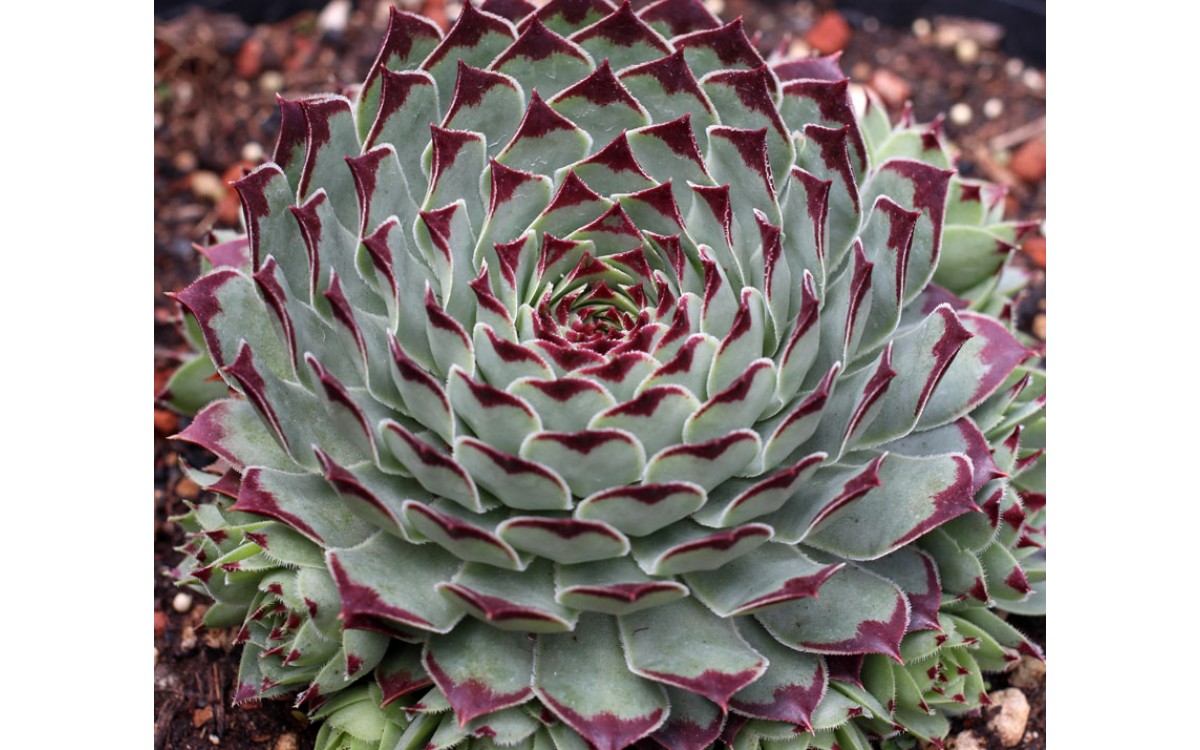
Houseleeks: our temperate alternative to aloe vera in skincare
A perennial feature of the garden I grew up in was the spiky little plants that ran in shallow beds along the edge of the terrace. While I’d happily pluck flowerheads from elsewhere and shred petals into jam jars to make perfumes and potions, the sharp points of the sempervivums seemed to say ‘be wary’. However, through my childhood years I came to appreciate their unchanging presence and ended up loving their constancy and familiarity.
My fascination and respect has returned in recent years as I seek temperate-grown plants to create beneficial skincare and discovered the ancient associations and skincare benefits of sempervivums, more fondly known as houseleeks.
Houseleeks endure because they can hold water within their fleshy leaves – much like the tropical aloe vera. Researching houseleeks in skincare recipes, I found many similarities with how we use aloe vera. Both plants are go-to ingredients when a caring lubricant with some substance is needed. They appear in cleansers and gels, for adding moisture into creams and soaps, providing cooling healing in salves and treatments for damaged hair.
As a viable alternative to aloe vera that we can grow in abundance in this climate, I think houseleeks are worth investigating further. So I’ve trialled traditional houseleek skincare recipes and adapted some aloe vera recipes to use houseleek instead.
‘Be wary’ they said
This is untested territory, so we proceed with caution. Many plants and herbs used traditionally for healing and skincare have not had the rigorous scientific testing that pharmaceutical ingredients benefit from. Electing to use these is a matter of personal choice and selections should be made with care and understanding, paying attention to what is known about the plants and, particularly, how our own skin responds.
Aloe vera has not had testing that would give it pharmaceutical status. Its use, however, can be dated back to the earliest medical papyrus’ and it is widely used and accepted in many treatments.
Houseleeks have not been subjected to medical scrutiny, to my knowledge. Instead, we are reliant on the tried-and-tested advice from centuries of apothecaries.
As consumers collectively call for natural ingredients to be used in skincare, more testing is taking place on plant-based ingredients. Result often collude with the traditional folk advice. For example, a recent clinical study into elderflowers provides evidence that they are active in managing under-eye bags and dark circles, something they have long been used for in folk traditions.
Houseleeks – a growing trend
Houseleeks are trending in interior décor. Part of a re-dawning realisation of the benefits of houseplants. Maybe it’s because they’re compact, funky, have about forty different varieties and are incredibly hard to kill off (while being easy to multiply); but they’re certainly not a new thing. Houseleeks have been in our homesteads for as long as we’ve been living in settled communities. ‘Leac’ is the Anglo-Saxon word for plant, so they are literally ‘house plants’. Their popularity is dated to Charlemagne’s (742-814) instruction to plant them on roofs as a protection from lightning. Still now houseleeks appear on green roofs, but more typically for their low maintenance, evergreen qualities than any reasons of sorcery.
A houseleek by any other name is still a houseleek
Houseleek’s numerous folk names are evidence of its commonality: ‘liveforever’ ‘Sengreen’, ‘Ayron’ and ‘Ayegreen’ all reference its endurance. More obscure is: ‘Old-man-and-woman’ and the wonderful ‘welcome-home-husband-though-never-so-drunk’. ‘Hen and chicks’ describes the ‘mother hen’ rosette and satellite chicks offsets (a feature that makes houseleeks a great plant for sharing – giving a tiny ‘chick’ is a wonderful gesture of friendship).
Their associations with protection from storms is indicated by the names ‘Jupiter’s Eye’, ‘Jupiter’s Beard’, ‘Barba Jovis’ ‘Thor’s Beard’ and the German ‘Donnersbart’ (or ‘thunderbeard’) from the Roman and Nordic gods. As well as ‘Bullock’s Eye’, or ‘Joubarbe de toits’ in French referencing the massive beard-like clusters of flowers that could form.
Houseleeks in temperate climates
Most succulents are associated with warm, desert-like climates where the ability to hold water in their leaves is a necessity for survival. Houseleeks can be found in these conditions (from the Sahara to the Caucasus) but also use their water-storage ability to enable survival in rocky heights and are sufficiently frost resistant to thrive in these areas, as well as across Europe and North America in general.
While not strictly indigenous to the UK, houseleeks were introduced by the Romans who liked to grow them in vases in front of their homes – believing them a protector and aphrodisiac. They have continued to be a common sight on roofs across Europe for centuries. In Hans Christian Anderson’s story ‘What the Moon Saw’ he describes ‘the roof of each house is overgrown with moss and with yellow flowers and houseleek’. Indeed, Linnaeus observed houseleeks used to help preserve thatched roofs in Sweden – their association with roofs is preserved in the specific name he gave them ‘tectorum’.
Beneficial properties of houseleeks
I’m interested in houseleeks because they are succulents that grow in a temperate climate – so the healing benefits of gelatinous leaves come with the benefit of local affinity. Their medicinal benefits are part of our long tradition of using houseleeks. They were traditionally applied directly to the skin much in the way we turn to aloe vera today – for treating burns, warts and bites. Houseleeks contain fumaric and malic acid, plant mucus, fatty oil, tannin, resin, calcium and malate. In folk medicine they are used for their anti-inflammatory, astringent and diuretic properties, typically in the form of juice, poultices, salves, creams, tinctures or tea.
A place in my garden
If you’re tempted to make a switch to houseleeks, a few of my recipes are offered here. There are more on my website including eye gel, foot soak, face mask, hand sanitiser, lip scrub, shaving gel and aftershave www.fieldfreshskincare.co.uk. I admit to being hooked on this enduring little plant, and really appreciating that it is juicy, fleshy and delightfully numerous.
Here are 10 fantastic blend-it-yourself recipes to benefit from houseleeks in your skincare
Advice from the apothecaries
While much reference is made to the anti-inflammatory, astringent and diuretic benefits of houseleeks; accompanying warnings suggest, as with most things, to use in moderation – a large dose of houseleek can be purgative and emetic
Culpeper (1616-1654) was a big fan of houseleeks, he said: ‘Our ordinary Houseleek is good for all inward heats, as well as outward, and in the eyes or other parts of the body: a posset made of the juice is singularly good in all hot agues, for it cooleth and tempereth the blood and spirits and quencheth the thirst; and is also good to stay all defluction or sharp and salt rheums in the eyes, the juice being dropped into them. If the juice be dropped into the ears, it easeth pain…. It cooleth and restraineth all hot inflammations St. Anthony’s fire (Erysipelas), scaldings and burnings, the shingles, fretting ulcers, ringworms and the like; and much easeth the pain and the gout.’
After describing the use of the leaves in the cure of corns, he goes on to say: ‘it easeth also the headache, and the distempered heat of the brain in frenzies, or through want of sleep, being applied to the temples and forehead. The leaves bruised and laid upon the crown or seam of the head, stayeth bleeding at the nose very quickly. The distilled water of the herb is profitable for all the purposes aforesaid. The leaves being gently rubbed on any place stung with nettles or bees, doth quickly take away the pain.’
Parkinson (1755-1824) tells us: ‘The juice takes away corns from the toes and feet if they be bathed therewith every day, and at night emplastered as it were with the skin of the same House Leek.’
Gerard (1545-1612) tells us the: ‘juice of Houseleeke, Garden Nightshade and the buds of Poplar, boiled in hog’s grease, maketh the most singular Populeon that ever was used in Chirugerie.’ He also recommends ‘The juice being gently rubbed on any place stung by nettles, or bees, or bitten by any venomous creature, doth presently take away the pain. Being applied to the temples and forehead it easeth also the headache and distempered heat of the brain through want of sleep.’
Galen (c.AD129-200) recommends houseleek for erysipelas and shingles
Dioscorides (c.AD40-90) suggests houseleek as a remedy for weak and inflamed eyes.
Pliny (c.AD23-79) says houseleek never fails to produce sleep.
In the fourteenth century houseleek was used as an ingredient of a preparation for neuralgia, called hemygreyne (megrim) and an ointment used for scalds and burns.
Real folk remedies
Collected folk memoires from around the United Kingdom and beyond have made reference to the use of houseleeks for a familiar collection of ailments.
From Swansea there is anecdotal evidence that the leaves were crushed so the juice could be mixed with butter and applied to acne. The use of houseleeks to combat warts has been recorded in Yorkshire, Scotland and Kent, all reporting the juice from a broken leaf to be held on with a plaster overnight, repeating until the wart disappears. In Newcastle the houseleek liquid was boiled to a pulp and applied as a remedy for shingles. Squeezing a few drops of juice from leaf of a houseleek onto the affected part was thought to cure earache in Yorkshire, impetigo in Norfolk, a cut finger in Spain and burns in the United States.

